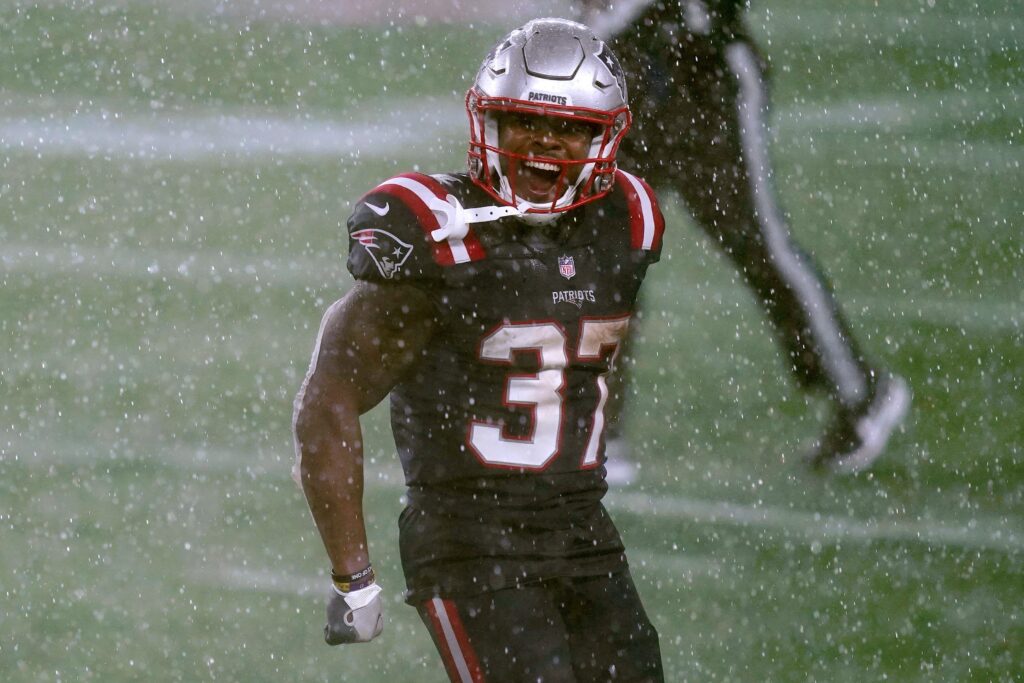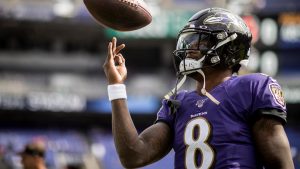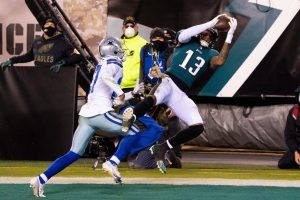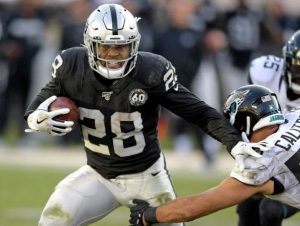Trends and Takes: Week 11

Written by Timothy Lewis (@TrendsAndTakes) — November 19th, 2020
Week 10 of the 2019 NFL season has come and gone! In other words, we have a 10-game sample size to spot trends and develop takeaways. Welcome to season four of this column! If you’re not familiar, I use this time to look at numbers and tell you what I make of them. This year, I will be offering additional Buy/Sell/Drop/hold criteria. Statistics are courtesy of advanced analytics goldmine, Player Profiler, and trusty dusty Pro-Football-Reference.
T.J. Hockenson
The Trends:
25% Red zone target share
Averaging 3.3 yards after catch
7.0 yards per target (20th in NFL)
Hasn’t topped 65 receiving yards since week 1, 2019
The Takes:
The T.J. Hockenson breakout has yet to arrive. His former college teammate and positional doppelganger, Denver’s Noah Fant, has appeared to be the more dynamic player at the NFL level.
That’s not to say the former has been a disappointment, just that he’s underwhelmed. Heralded as the next coming at the position, Hockenson has been very average. Ranking 8th in receiving yards isn’t bad, but it’s also not exceeding his target numbers, where he also ranks 8th. Value, however, is all about perspective. This season, averaging Hockenson’s 4 receptions for 40 yards is reassuring, considering the positional landscape.
Combining a towering 6’5” frame, terrific college production, and eye-popping athletic measurables, the former first round pick still possesses tantalizing potential. It’s time for that potential to meet production. While the Lions’ tight end is averaging 3.3 yards after the catch, this statistic betrays the fact that Hockenson has been a catch-and-fall-down possession receiver. The number is inflated by craftily schemed screens that have practically gifted post-reception yardage. While this schematic tendency seems favorable for Hockenson, his inability to realize chunk air yardage is the real story.
Rarely does Hockenson shake the first tackler or achieve significant separation. He doesn’t have the game-breaking speed of a George Kittle or Fant, and it shows on tape. There needs to be a fundamental shift in the way the second-year tight end maneuvers with the ball, because his attempt to run around defensive players is inadequate at the NFL level. He must embrace his enormous physicality to punish would-be tacklers.
Ranking 12th in air yards, it appears the Lions want to deceive defenses with Hockenson’s dual faculties as both a blocker and a receiver. You’ll often see him trick linebackers into thinking he’s blocking in an under-center formation, only for him to burst off of the line of scrimmage for a quick-hit pass. This role caps the upside of the sophomore tight end, as he’s not getting the chance to make splash plays down field.
With Kenny Golladay gone for much of the season, the opportunity has been there for a pass catcher to ascend. While no single receiver has asserted themselves as an alpha presence in Golladay’s stead, Hockenson has stepped up to absorb the red zone and end zone targets. As a rookie, he averaged a 13.7% red zone target share. That figure has skyrocketed to 25% in 2020.
Verdict: The argument isn’t whether or not Hockenson has met expectations as an NFL player (give him time), but if he is a valuable contributor in fantasy football. 4 catches for 40 yards and .5 touchdowns per game is stellar this season. However, it was Golladay who occupied 25% of red zone targets the season prior, and he’s expected back this week. That will compromise Hockenson’s biggest source of value. SELL.
Chase Claypool
The Trends:
20.5% TD rate
17% target share
16 deep targets (8th in NFL)
Averaging 4.1 yards after catch
The Takes:
If you’ve been reading this column, you know my methodology for identifying elite receivers: A combination of deep targets and yards after catch. A receiver who garners high-leverage targets downfield, while also making plays with the ball in their hands, possesses the ubiquity necessary for an expanded role.
There’s no pass catcher on the Steelers who intersects on this matrix the way Chase Claypool does. Juju is the low ADOT slot receiver, while Diontae Johnson is a volume-driven compiler on the outside. While both of these men occupy 20%+ target shares, they have been decidedly out-shined by the rookie Claypool.
The 20.5% touchdown rate boasted by the Notre Dame product is absurd and clearly unsustainable. While it’s not projectable going forward, it’s indicative of the rare brand of playmaker Claypool is. He’s well on his way to being a Tyreek Hill/, D.K. Metcalf brand of outlier.
Like the aforementioned names, he’s an unbelievable athlete who wins downfield and after the catch.
What’s more, is that Claypool has become a red zone favorite, occupying over 15% of these targets. While the Steelers have failed to commit to him as an every-down player, the usage pattern demonstrates a tacit recognition of who the team’s best pass catcher is.
Another recognition is Claypool’s targets per snap, receiving a target on nearly 16% of the snaps he’s on the field. That’s why, despite a modest target share on an offense that’s not particularly pass heavy, the rookie has averaged over 10 targets per game in his last three contests.
Verdict: Claypool appears to be every bit the Martavis Bryant replacement, and then some. However, it’s naive to assume he asserts himself into an even more prominent role, as there are still a number of talented pass catchers on this team. Even with this outlier status, the touchdown rate will have to come back to reality. Even still, Claypool is worth every week consideration as a WR2/Flex option. HOLD.
Damien Harris
The Trends:
Averaging 17 carries over the past 3 games
6 runs of 15 yards or more (6th in NFL)
Averages 7.3 defenders in the box (1st in NFL)
Averaging 5.5 yards per carry
The Takes:
The ever-trendy Damien Harris is finally making his mark on an NFL field, after being selected in the third round of the 2019 draft and receiving just four touches his rookie season. Notoriously difficult to decipher, the addition of Cam Newton has made the Patriots’ backfield more of a headache.
James White has a 35% snap share, Rex Burkhead sits at 44%, and Damien Harris ranks between the two at 37%. Where Harris is out-competing his stablemates is in opportunity share, logging 46% of the team’s running back touches. This number is a bit misleading, however, as the Alabama product is experiencing an uptick in usage the past three weeks, now solidifying himself as the team’s go-to force between the tackles.
NFL defenses have taken notice of the Patriots’ run-heavy scheme, cracking down and loading the box. However, in standard Belichick fashion, he’s leaning into his strengths, pummeling defenses on the ground with utter disregard for the opponent’s preparation. Cam Newton is freezing linebackers and Damien Harris has been realizing the benefits.
Unfortunately, the presence of Cam Newton also comes with a cost. He’s the big dog, and big dogs have to eat. Despite his splendid efficiency, Harris has occupied the role of between-the-20’s grinder, averaging 1 measly touch per game in the red zone. While it became fashionable to project Harris into the LeGarrette Blount role, devouring goal line opportunities like Joey Chestnut with a tray full of hotdogs. So far this season, Harris has accumulated a single goal line carry, totaling just one touchdown. Newton, meanwhile, has nine rushing touchdowns.
It’s actually Rex Burkhead who has been the preferred back in goal line packages, ostensibly due to his solid frame and diverse skill profile. That said, we don’t know if the similarly-framed Harris is capable of occupying such a role, as he’s received just two targets all season after receiving praise for his work as a receiver in the offseason. As always, there’s a shroud of mystery surrounding touch distribution with this backfield.
The Verdict: Harris is riding a high after registering 100 rushing yards in two out of the past three games. These tallies could invigorate a running-back needy team to pony up. However, the peripherals here aren’t good. Harris is eating up low-calorie rushing yards, while being denied high-leverage receiving and red zone opportunities. He’s an RB3 you may be able to SELL as an RB2.



